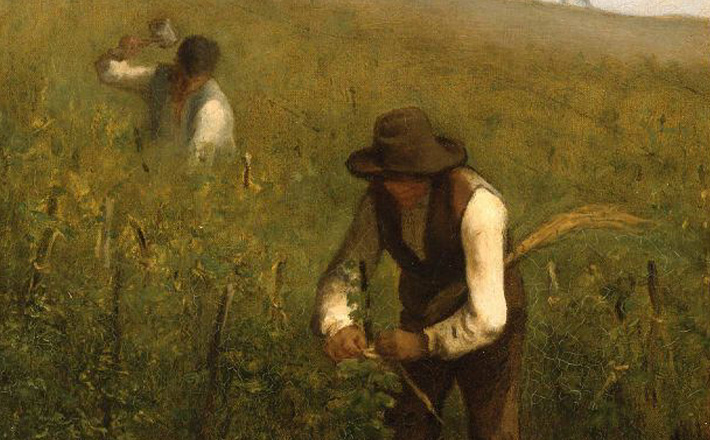Commentary on Hebrews 11:29—12:2
This week’s second lesson continues the reading of Chapter 11 of Hebrews begun last week.
The focus of last week’s selections (11:1-3, 8-16) was the faith of Abraham and Sarah. Today’s text follows a similarly expansive review of the faith of Moses that began in verse 23. Once the text leaves Moses, however, the examples of those who lived “by faith” fly by in rapid fashion as “time fails” the narrator (verse 32).
The sketches are quickly done with imaginatively broad-brush strokes. It is not always clear which OT heroes and heroines of the faith the text has in mind. Interestingly, as Sarah was lifted up in last week’s text as an exemplar of faith, women again figure prominently in this week’s narrative. Rahab “the prostitute” (verse 31) is singled out for special honors as well as are the women who “received their dead by resurrection” (verse 35), presumably referring to the mothers whose children were raised by Elijah and Elisha.
With regard to Rahab, the NRSV’s alternative translation is preferred: “Rahab … did not perish with those who were unbelieving (i.e., in the promises of God).” Rahab’s saving grace was that, because of her belief in the promised future of God’s people, she “received the (Israelite) spies in peace” (verse 31). This reception of holy spies/strangers by a Canannite whore is a jarring example of Hebrews’ understanding of faith that, among other things, leads to the practice of radical hospitality (explicitly commended in 13:1).
In its own way this illustration of the “faith” of Rahab is as transgressive as is Hebrews’ understanding that the Cannanite priest/king Melchizedek (rather than Aaron) establishes the “order” of Christ’s priesthood (5:6). Marginal outsiders become core identifiers of not only Christian identity (Rahab) but Christ himself (Melchizedek). Abraham was not the only ancestor who, though “as good as dead,” through faith gave birth to descendants “as many as the stars of heaven and as the innumerable grains of sand by the seashore” (11:12).
In verse 32, Chapter 11’s eclectic list of the heroes of faith includes some from among the Judges of Israel (Gideon, Samson, Jephthah, Samuel), one commissioned by a Judge (Barak), David, as well as the prophets. Verse 33 begins a run of heroic activities that are not clearly attached to the names. Who, for example, “shut the mouths of lions”? Was it Daniel of lion’s den fame (not mentioned in the list by name)? Or perhaps Samson or David? Similarly, the descriptions of the various forms of abuse the saints of God endured beginning at verse 35 (torture, mocking, flogging, chains, imprisonment, stoning, being sawn in two, killed by the sword, etc.) are not linked to specific figures.
In fact, exegetes are hard-pressed to come up with OT referents for some of the details of the descriptions (e.g., “sawn in two” verse 37?), though the majority feels that the recitation ends with an encomium to the Maccabean martyrs. Yet the fact that most of the faithful witnesses remain nameless (and are thus characterized only by their struggles) is no doubt intentional. By the end of the passage one is persuaded not only of the great numbers of those of faith that have gone before, but the strong and quite creative endurance of this long chain of witnesses “of whom the world was not worthy” (verse 38). Somewhat hidden behind this list, of course, is a God who is both worthy of such loyalty and the one actually equipping people with the faith that makes resistance to the enemies of God possible, the foremost of which is suffering that leads to death.
Then comes this remarkable claim: that for all of their greatness, these saints of faith did not receive what was promised. Their completion — their “perfection” — awaited the in-breaking of God’s invisible Word in the incarnate Christ (1:2), his perfect sacrifice (1:3; 9:26; 10:12), and glorification at the right hand of God. In fact, their perfection still awaits the full realization of the “unshakable” kingdom of God that the present saints of God are in the process of receiving (12:28; cf. 9:28).
The pericope closes with an exhortation that employs an athletic metaphor, “Let us, therefore, run the race that is set before us” (12:1; cf. Philippians 3:12-15). Similar to the present day Olympic event, ancient marathon races could end in a stadium. A final lap would be made in the presence of onlookers (the “great cloud of witnesses,” 12:1) who are cheering the exhausted runners on. In Hebrews, the onlookers are the very saints of old described throughout Chapter 11, from Abel (“who still speaks,” 11:4) to the Maccabean martyrs. In the festive atmosphere of an Olympian celebration, they await the race’s end with eager anticipation.
Yet this race, the text reminds, is different from all others. The course has been marked by Christ, “the pioneer and perfecter of our faith.” Only Jesus has run this course to its end, though by doing so has made it possible for all others to follow. The primary obstacle he faced, the shame of the cross (12:2), is vanquished by the power of the resurrection. In following the Christ crucified and risen, one is led through the obstacles of which life is full, including deep disgrace and suffering, and even death itself (10:38-40).
According to Hebrews, at the end of this race — this course of life — awaits Christ, enthroned “at the right hand of God” (12:2). It is into this “invisible” presence (11:2) we lean forward in faith as we run the course now set by Christ before us. When the last of the runners make it across the finish line, Hebrews suggests, the stands of the stadium will empty. The city of the living God, made up of “the spirits of the righteous made perfect” will form around the enthroned Christ and “innumerable angels in festal gathering” (12:22). Sin, suffering, death — all the enemies of God — will be no more. Remarkably, this on-going “perfect” worship of God is mediated a high priest who is Christ himself (6:20; 5:2).
It is striking that Hebrews’ exegesis of divine “service” does not end in this beatific vision of the goal of Christ’s victory over sin and death on the cross. In Chapter 13, while meditating on the fact that Jesus’ sacrifice is not offered in the holy precincts of the temple but on a Roman killing field “outside the camp,” Hebrews exhorts, “Let us then go to him outside the camp and bear the abuse he endured” (13:13).
The (a) holy service to the enthroned Christ and the (b) cruciform service directed to our fellow humans in need are, somehow, bound together in the ongoing reconciliation God has effected in Christ. It is precisely for this worship of Christ — a service both holy and profane — that Hebrews invites us to “lay aside every weight and the sin that clings so closely,” so that we might “run with perseverance the race that is set before us” (12:1).


August 18, 2013